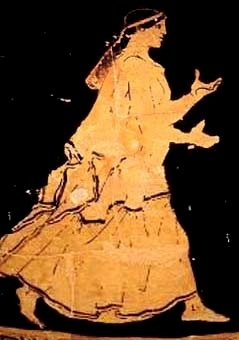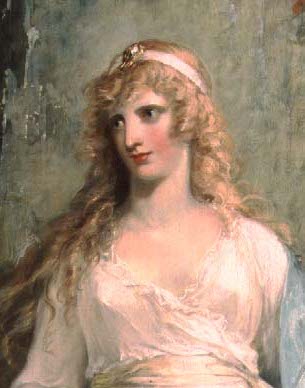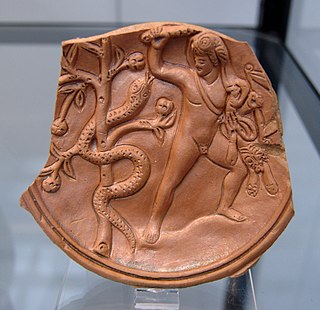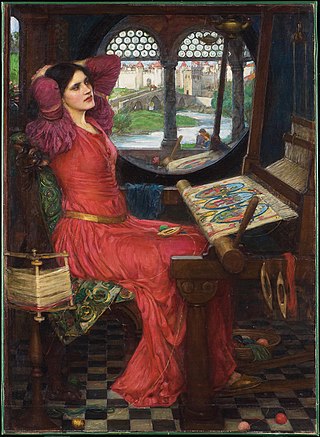
In Greek mythology, Hypnos also spelled Hypnus is the personification of sleep; the Roman equivalent is known as Somnus. His name is the origin of the word hypnosis. Pausanias wrote that Hypnos was a dearest friend of the Muses.

A nymph, sometimes spelled nymphe, in ancient Greek folklore is a minor female nature deity. Different from other Greek goddesses, nymphs are generally regarded as personifications of nature, are typically tied to a specific place or landform, and are usually depicted as maidens. They were immortal like other goddesses, except for the Hamadryads, whose lives were bound to a specific tree.

In Greek mythology, Atlas is a Titan condemned to hold up the heavens or sky for eternity after the Titanomachy. Atlas also plays a role in the myths of two of the greatest Greek heroes: Heracles and Perseus. According to the ancient Greek poet Hesiod, Atlas stood at the ends of the earth in extreme west. Later, he became commonly identified with the Atlas Mountains in northwest Africa and was said to be the first King of Mauretania. Atlas was said to have been skilled in philosophy, mathematics, and astronomy. In antiquity, he was credited with inventing the first celestial sphere. In some texts, he is even credited with the invention of astronomy itself.

The Statue of Zeus at Olympia was a giant seated figure, about 12.4 m (41 ft) tall, made by the Greek sculptor Phidias around 435 BC at the sanctuary of Olympia, Greece, and erected in the Temple of Zeus there. Zeus is the sky and thunder god in ancient Greek religion, who rules as king of the gods of Mount Olympus.

Asclepius is a hero and god of medicine in ancient Greek religion and mythology. He is the son of Apollo and Coronis, or Arsinoe, or of Apollo alone. Asclepius represents the healing aspect of the medical arts; his daughters, the "Asclepiades", are: Hygieia, Iaso, Aceso, Aegle and Panacea. He has several sons as well. He was associated with the Roman/Etruscan god Vediovis and the Egyptian Imhotep. He shared with Apollo the epithet Paean. The rod of Asclepius, a snake-entwined staff, remains a symbol of medicine today. Those physicians and attendants who served this god were known as the Therapeutae of Asclepius.

The caduceus is the staff carried by Hermes in Greek mythology and consequently by Hermes Trismegistus in Greco-Egyptian mythology. The same staff was also borne by heralds in general, for example by Iris, the messenger of Hera. It is a short staff entwined by two serpents, sometimes surmounted by wings. In Roman iconography, it was often depicted being carried in the left hand of Mercury, the messenger of the gods.

In ancient Greek mythology and religion, Selene is the goddess and personification of the Moon. Also known as Mene, she is traditionally the daughter of the Titans Hyperion and Theia, and sister of the sun god Helios and the dawn goddess Eos. She drives her moon chariot across the heavens. Several lovers are attributed to her in various myths, including Zeus, Pan, and the mortal Endymion. In post-classical times, Selene was often identified with Artemis, much as her brother, Helios, was identified with Apollo. Selene and Artemis were also associated with Hecate and all three were regarded as moon and lunar goddesses, but only Selene was regarded as the personification of the Moon itself. Her Roman equivalent is Luna.
In Greek mythology and Roman mythology, Erebus, or Erebos, is the personification of darkness and one of the primordial deities. Hesiod's Theogony identifies him as one of the first five beings in existence, born of Chaos.

In Greek mythology, Psamathe is a Nereid, one of the fifty daughters of the sea god Nereus and the Oceanid Doris. By Aeacus, the king of Aegina, she is the mother of a son, Phocus. When Phocus is killed by his half-brothers Peleus and Telamon, Psamathe sends a giant wolf at Peleus' herd.

Nyx is the Greek goddess and personification of night. A shadowy figure, Nyx stood at or near the beginning of creation and mothered other personified deities, such as Hypnos (Sleep) and Thanatos (Death), with Erebus (Darkness). In Hesiod's Theogony, she is produced from Chaos.

In Greek mythology, dreams were sometimes personified as Oneiros or Oneiroi. In the Iliad of Homer, Zeus sends an Oneiros to appear to Agamemnon in a dream, while in Hesiod's Theogony, the Oneiroi are the sons of Nyx (Night), and brothers of Hypnos (Sleep).

John William Waterhouse was an English painter known for working first in the Academic style and for then embracing the Pre-Raphaelite Brotherhood's style and subject matter. His paintings are known for their depictions of women from both ancient Greek mythology and Arthurian legend. A high proportion depict a single young and beautiful woman in a historical costume and setting, though there are some ventures into Orientalist painting and genre painting, still mostly featuring women.

In Greek mythology, Calypso was a nymph who lived on the island of Ogygia, where, according to Homer's Odyssey, she detained Odysseus for seven years. She promised Odysseus immortality if he would stay with her, but Odysseus preferred to return home.

Maia, in ancient Greek religion and mythology, is one of the Pleiades and the mother of Hermes, one of the major Greek gods, by Zeus, the king of Olympus.

In Greek mythology, Aether, Æther, Aither, or Ether is the personification of the bright upper sky. According to Hesiod, he was the son of Erebus (Darkness) and Nyx (Night), and the brother of Hemera (Day). In Orphic cosmogony Aether was the offspring of Chronos (Time), and the brother of Chaos and Erebus.
Agora, also called Cherronesos or Chersonesos, was an ancient Greek town in Thrace. It was situated about the middle of the narrow neck of the Thracian Chersonese, and not far from Cardia, in what is now European Turkey.

Ladon was a monster in Greek mythology, the dragon that guarded the golden apples in the Garden of the Hesperides.

The Lady of Shalott is a painting of 1888 by the English painter John William Waterhouse. It is a representation of the ending of Alfred, Lord Tennyson's 1832 poem of the same name. Waterhouse painted three versions of this character, in 1888, 1894 and 1915. It is one of his most famous works, which adopted much of the style of the Pre-Raphaelite Brotherhood, though Waterhouse was painting several decades after the Brotherhood split up during his early childhood.

I Am Half-Sick of Shadows, Said the Lady of Shalott is a painting by John William Waterhouse completed in 1915. It is the third painting by Waterhouse that depicts a scene from the Tennyson poem, "The Lady of Shalott". The title of the painting is a quotation from the last two lines in the fourth and final verse of the second part of Tennyson's poem:

Portrait painting in Scotland includes all forms of painted portraiture in Scotland, from its beginnings in the early sixteenth century until the present day. The origins of the tradition of portrait painting in Scotland are in the Renaissance, particularly through contacts with the Netherlands. The first portrait of a named person that survives is that of Archbishop William Elphinstone, probably painted by a Scottish artist using Flemish techniques around 1505. Around the same period Scottish monarchs turned to the recording of royal likenesses in panel portraits, painted in oils on wood. The tradition of royal portrait painting in Scotland was probably disrupted by the minorities and regencies it underwent for much of the sixteenth century. It began to flourish after the Reformation, with paintings of royal figures and nobles by Netherlands artists Hans Eworth, Arnold Bronckorst and Adrian Vanson. A specific type of Scottish picture from this era was the "vendetta portrait", designed to keep alive the memory of an atrocity. The Union of Crowns in 1603 removed a major source of artistic patronage in Scotland as James VI and his court moved to London. The result has been seen as a shift "from crown to castle", as the nobility and local lairds became the major sources of patronage.



















